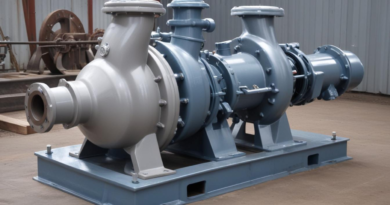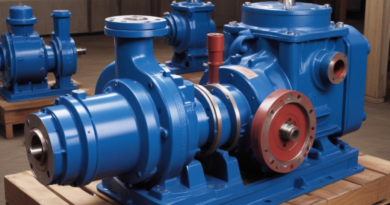the role of pumps in irrigation systems
Irrigation systems rely on a variety of pumps, each designed to meet specific requirements based on the application’s scale, water source, and desired flow rate. Understanding the different types of irrigation pumps is essential for selecting the most suitable option for effective water distribution.
- Centrifugal Pumps: These are among the most commonly used irrigation pumps due to their simplicity and efficiency. They operate by converting rotational energy from a motor into kinetic energy in the water, facilitating continuous flow. Centrifugal pumps are ideal for large-scale agricultural operations where a steady and high-volume water supply is necessary.
- Positive Displacement Pumps: Unlike centrifugal pumps, positive displacement pumps move water by trapping a fixed amount and forcing it through the system. This category includes:
- Diaphragm Pumps: Suitable for handling water with debris, as their design minimizes clogging.
- Piston Pumps: Provide high pressure and are effective for applications requiring precise water delivery.
- Submersible Pumps: Designed to operate underwater, these pumps are ideal for deep wells and boreholes. Their ability to push water to the surface makes them suitable for areas where water needs to be extracted from significant depths.
- Solar-Powered Pumps: Leveraging renewable energy, solar-powered irrigation pumps are increasingly popular in regions with ample sunlight. They offer an environmentally sustainable option, reducing reliance on traditional energy sources and lowering operational costs.
- Jet Pumps: Utilizing a jet of water to create suction, jet pumps are effective for shallow wells. They are often used in smaller irrigation systems where simplicity and affordability are key considerations.
| Type of Pump | Key Features | Common Applications |
|---|---|---|
| Centrifugal Pump | High flow rates, continuous operation, low maintenance | Large-scale agriculture, irrigation canals |
| Positive Displacement Pump | Handles viscous fluids, precise flow control | Drip irrigation, areas with debris-laden water |
| Submersible Pump | Operates underwater, efficient for deep wells | Deep boreholes, groundwater extraction |
| Solar-Powered Pump | Energy-efficient, sustainable, low operating costs | Remote farms, eco-friendly irrigation projects |
| Jet Pump | Simple design, cost-effective for shallow wells | Small farms, residential irrigation systems |
Selecting the appropriate irrigation pump type involves considering factors such as water source, elevation difference, energy availability, and specific agricultural needs. Each pump type offers distinct advantages, contributing to the overall functionality and efficiency of the irrigation system.
selecting the right pump for your system
Selecting the optimal pump for an irrigation system requires a comprehensive evaluation of several critical factors to ensure the system’s efficiency and reliability. Key considerations include the water source, desired flow rate, pressure requirements, energy availability, and the specific agricultural needs of the operation.
Water Source and Quality: Understanding the origin and quality of the water is paramount. Factors such as the presence of debris, sediment, or varying salinity levels can influence the choice of pump. For instance, waters with high particulate matter are better suited for positive displacement pumps, which can handle debris without frequent clogging.
Flow Rate and Pressure Requirements: Determining the necessary flow rate (measured in gallons per minute or liters per second) and the pressure needed to deliver water effectively across the irrigation system is essential. High-flow applications, like large-scale field irrigation, may benefit from centrifugal pumps, whereas precise applications, such as drip irrigation, might require piston pumps for accurate water delivery.
Energy Source and Efficiency: The availability and cost of energy sources play a significant role in pump selection. Solar-powered pumps offer sustainability and lower operational costs, particularly in remote areas with ample sunlight. Conversely, traditional electric or diesel-powered pumps might be more suitable in regions where consistent energy supply is available.
Elevation and Distance: The elevation difference between the water source and the irrigation area, as well as the distance the water must travel, affects pump performance. Submersible pumps are ideal for deep wells, effectively pushing water to the surface over significant heights, while jet pumps are better suited for shallow wells and shorter distances.
Budget and Cost Considerations: Initial investment, installation costs, and long-term maintenance expenses must be evaluated. While some pump types may have higher upfront costs, their durability and efficiency can lead to cost savings over time. Creating a cost-benefit analysis can aid in making an informed decision.
Compatibility with Existing Infrastructure: Ensuring that the selected pump integrates seamlessly with the current irrigation infrastructure is crucial. This includes matching pump fittings, motor compatibility, and control systems to avoid extensive modifications.
Scalability and Future Needs: Anticipating future expansion or changes in agricultural practices can influence pump selection. Choosing a pump system that can be easily scaled or adjusted ensures longevity and adaptability of the irrigation system.
The following table summarizes these considerations to aid in the decision-making process:
| Consideration | Details | Impact on Pump Selection |
|---|---|---|
| Water Source | Origin, quality, and sediment levels | Determines pump type and filtration needs |
| Flow Rate & Pressure | Required gallons per minute and pressure levels | Influences pump capacity and type |
| Energy Availability | Access to electricity, solar potential, fuel costs | Affects operational costs and pump choice |
| Elevation & Distance | Height difference and transport distance of water | Determines pump power and placement |
| Budget | Initial and ongoing costs | Guides pump type and features selected |
| Infrastructure Compatibility | Existing system fittings and controls | Ensures seamless integration and functionality |
| Scalability | Potential for system expansion | Facilitates long-term system adaptability |
By systematically evaluating these factors, stakeholders can make informed decisions that enhance the functionality and sustainability of their irrigation systems, ensuring that the chosen pump aligns with both current needs and future demands.
pump installation and maintenance
Proper installation is crucial for ensuring the optimal performance and longevity of irrigation pumps. It involves several key steps, each essential for the pump’s functionality and efficiency.
- Site Selection: Choose a location that is easily accessible for maintenance and provides adequate protection from environmental elements. Ensuring the site is level helps prevent vibration and reduces wear on pump components.
- Foundation Preparation: A stable and level foundation minimizes movement and noise, extending the pump’s lifespan. Utilize concrete pads or other suitable materials to secure the pump firmly.
- Electrical Connections: Ensure all electrical connections comply with local codes and are installed by a qualified electrician. Proper wiring is essential for the safe and efficient operation of the pump.
- Plumbing Connections: Correctly connect the pump to the water source and irrigation system using appropriate piping and fittings. Proper sealing prevents leaks and maintains system pressure.
- Pump Priming: Before starting the pump, ensure it is properly primed to remove air from the system. This step is vital for pumps that cannot self-prime.
Regular maintenance is vital to ensure the continued performance and reliability of irrigation pumps. A systematic maintenance schedule can prevent unexpected failures and extend the pump’s lifespan.
- Daily Checks:
- Inspect the pump for any signs of leaks or unusual noises.
- Ensure that the pump is operating smoothly without excessive vibration.
- Weekly Maintenance:
- Clean intake screens to prevent debris from entering the pump.
- Check and maintain proper tension on belts and other moving parts.
- Verify electrical connections are secure and free from corrosion.
- Monthly Maintenance:
- Inspect all seals and gaskets, replacing them if signs of wear are observed.
- Lubricate bearings and other components as specified by the manufacturer.
- Check alignment of pump and motor to prevent undue stress.
- Annual Maintenance:
- Perform a comprehensive inspection of the entire pump system.
- Replace any worn or damaged parts.
- Test system performance to ensure it meets required specifications.
| Maintenance Frequency | Tasks |
|---|---|
| Daily |
|
| Weekly |
|
| Monthly |
|
| Annual |
|
Adhering to these installation and maintenance practices not only enhances the functionality of irrigation pumps but also plays a significant role in reducing operational costs and improving the efficiency of the entire irrigation system. Regular upkeep ensures that pumps operate at peak performance, minimizing downtime and extending their service life.
energy efficiency in irrigation pumping
 Enhancing energy efficiency in irrigation systems not only reduces operational costs but also contributes to sustainable agricultural practices. Several strategies and technologies can be employed to optimize the energy consumption of irrigation pumps, ensuring both economic and environmental benefits.
Enhancing energy efficiency in irrigation systems not only reduces operational costs but also contributes to sustainable agricultural practices. Several strategies and technologies can be employed to optimize the energy consumption of irrigation pumps, ensuring both economic and environmental benefits.
- Variable Frequency Drives (VFDs): VFDs adjust the motor speed to match the required water flow, minimizing energy waste. By controlling the pump’s operational speed, VFDs ensure that energy is used only as needed, enhancing overall system efficiency.
- Proper Pump Selection and Sizing: Selecting a pump that matches the system’s specific requirements prevents overconsumption of energy. Oversized pumps can lead to excessive energy use, while undersized pumps may require more frequent operation to meet demand.
- Energy-Efficient Motors: Utilizing motors with higher efficiency ratings can significantly reduce energy consumption. Modern motors are designed to operate with minimal energy loss, providing the necessary power with greater efficiency.
- Optimized System Design: Designing the irrigation system to minimize friction losses and ensure smooth water flow can reduce the energy required for pumping. This includes using appropriately sized pipes and reducing unnecessary bends or obstructions in the system.
- Automated Scheduling and Controls: Implementing automation allows for precise control over pump operation times and durations. Automated systems can operate pumps during off-peak energy hours or adjust operations based on real-time demand, reducing energy usage.
- Regular Maintenance and Leak Detection: Ensuring that the pump and irrigation system are well-maintained prevents energy losses due to leaks or inefficiencies. Regular inspections and prompt repairs help maintain optimal energy performance.
Incorporating these energy-efficient practices can lead to substantial savings and enhance the sustainability of irrigation operations. The table below illustrates the impact of various energy efficiency measures on overall energy consumption:
| Energy Efficiency Measure | Potential Energy Savings | Impact on System Performance |
|---|---|---|
| Variable Frequency Drives (VFDs) | 20-50% | Increased control over pump speed, reduced wear and tear |
| Proper Pump Selection and Sizing | 15-30% | Optimal energy use, extended pump lifespan |
| Energy-Efficient Motors | 10-25% | Lower energy loss, improved motor performance |
| Optimized System Design | 10-20% | Reduced friction losses, smoother water flow |
| Automated Scheduling and Controls | 5-15% | Reduced energy usage during off-peak hours, enhanced operational efficiency |
| Regular Maintenance and Leak Detection | 5-10% | Prevention of energy losses, sustained system efficiency |
Renewable Energy Integration: Incorporating renewable energy sources, such as solar or wind power, can further enhance energy efficiency. Solar-powered pumps, for instance, reduce dependence on fossil fuels and lower energy costs, particularly in regions with high solar irradiance.
Water Management Practices: Efficient water management, including precise irrigation scheduling and employing water-saving techniques, can reduce the demand on pumps, thereby decreasing energy consumption. Techniques like drip irrigation and soil moisture sensors ensure water is used judiciously, aligning pump operations with actual crop needs.
Advanced Monitoring Systems: Implementing advanced monitoring and data analytics allows for real-time tracking of energy usage and system performance. These systems can identify inefficiencies, enabling timely interventions to maintain optimal energy performance.
By adopting these energy-efficient measures, agricultural operations can significantly reduce their energy footprint while maintaining the necessary functionality and performance of their irrigation systems. The role of irrigation pumps in this context is pivotal, as optimizing their energy use leads to more sustainable and cost-effective farming practices.
troubleshooting common pump issues
Identifying and resolving common issues with irrigation pumps is crucial to maintaining the system’s efficiency and ensuring uninterrupted water supply. Addressing these problems promptly can enhance the functionality and extend the lifespan of your irrigation pumps. Below are some of the most frequent issues encountered, along with their potential causes and recommended solutions:
| Issue | Possible Causes | Solutions |
|---|---|---|
| Pump Not Starting |
|
|
| Low Water Pressure |
|
|
| Overheating |
|
|
| Unusual Noises |
|
|
| Frequent Cycling On and Off |
|
|
Regular monitoring and prompt troubleshooting of these common issues can significantly reduce downtime and enhance the overall performance of your irrigation system. Additionally, implementing a proactive maintenance routine can help in early detection of potential problems, ensuring that irrigation pumps continue to operate efficiently and reliably.
Additional Troubleshooting Tips:
- Monitor Pump Performance: Keep a log of the pump’s performance metrics, such as flow rate and pressure, to identify any deviations from normal operation.
- Visual Inspections: Regularly inspect the pump and associated components for signs of wear, corrosion, or damage.
- Listen for Changes: Unusual sounds can be early indicators of mechanical issues. Addressing them early can prevent more severe problems.
- Ensure Proper Alignment: Misalignment between the pump and motor can cause excessive wear and inefficiency. Verify alignment during routine checks.
Implementing these troubleshooting practices not only maintains the role of irrigation pumps in ensuring effective water distribution but also optimizes their functionality, leading to more sustainable and productive agricultural operations.



